Multi-Domain Task Forces: A Glimpse at the Army of 2035
Multi-Domain Task Forces: A Glimpse at the Army of 2035
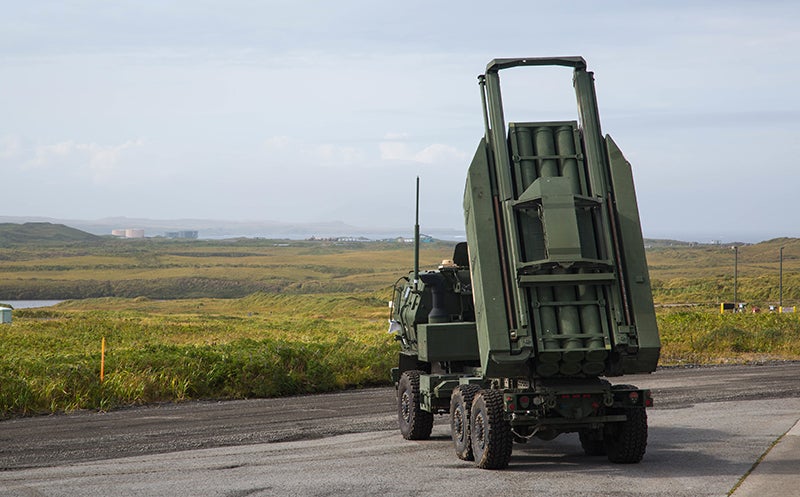
by Charles McEnany
Spotlight 22-2, March 2022
Issue
U.S. Army’s Multi-Domain Task Forces (MDTFs) represent the critical centerpiece in operationalizing the Army’s Multi-Domain Operations (MDO) concept, but their role and value in strategic competition is not fully understood by the joint force or Congress.
Spotlight Scope
Describes the structure, role and value of the Army’s MDTFs to joint force counter anti-access/area-denial capabilities across the spectrum of competition, crisis and conflict; and identifies challenges and considerations moving forward.
Insights
- MDTFs are a logical response to the era of strategic competition; long-range precision effects allow MDTFs to counter hybrid threats from China and Russia, while long-range precision fires enhance joint force freedom of maneuver should deterrence fail.
- Successful maneuver during competition forms the foundation for the MDTFs’ value in crisis or conflict by securing positions of advantage across all domains.
- MDTFs are inherently joint; not only do they augment joint force capabilities, but they rely on the successful modernization efforts of the Pentagon and the other services, most notably JADC2, to maximize their value to combatant commanders.
The three decades of “strategic respite,”1 absent a nation able to challenge the United States after the dissolution of the Soviet Union, are over. Tectonic shifts in geopolitics, namely the rise of China and the resurgence of Russia, coupled with rapid technological advancement, could make the United States’ next war unprecedented in its speed, lethality and reach.
Recognizing these currents, the U.S. Army has set out to modernize its entire enterprise for Multi-Domain Operations (MDO)—competing with, and if necessary, defeating, highly capable adversaries who can challenge the United States in the land, sea, air, space and cyberspace. The stakes for the Army are high; as then-commander of U.S. Army Pacific General Robert Brown said in 2019, “All formations will have to become multi-domain, or they’ll be irrelevant.”2
Charting the path forward to achieve this multi-domain capability are the Army’s Multi-Domain Task Forces (MDTFs). The two existing MDTFs—the first established in 2017 with an Indo-Pacific focus and a second stood up in 2021 in Europe—are the Army’s organizational centerpieces in employing the MDO concept. This Spotlight seeks to assess the MDTFs’ unique value to the joint force.
Strategic Environment
The 2018 National Defense Strategy (NDS) identifies the “reemergence of long-term, strategic competition” with China and Russia as the primary challenge to U.S. security.3 These strategic competitors intend to achieve their political aims by blurring the line between peace and conflict. Leveraging all instruments of national power—including political, military, economic, diplomatic, technological and informational capabilities—Beijing and Moscow seek to undermine the primacy of the United States.
First, China and Russia have undertaken significant military modernization with the goal of demonstrating capabilities to deter the United States from responding aggressively. Second, they are determined to blunt traditional U.S. military advantages and prevail in a conflict. Either scenario would alter regional and global balances of power—undermining U.S. military superiority and the political, economic and diplomatic strength it underpins.
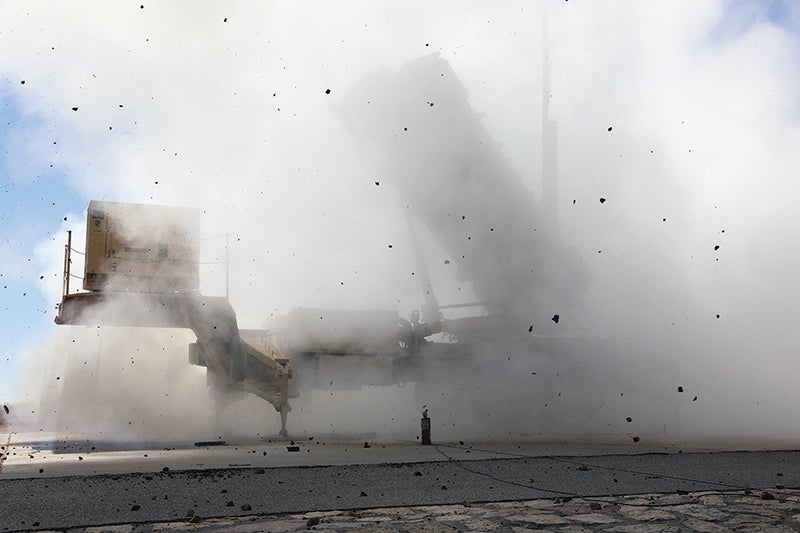
The Tyranny of Time: Anti-Access/Area-Denial
After studying U.S. operations, Beijing and Moscow have made anti-access/area-denial (A2/AD) central to their operational concept. According to the Congressional Research Service: “Anti-Access is defined as any action, activity, or capability, usually long-range, designed to prevent an advancing military force from entering an operational area. Area Denial is defined as action, activity, or capability, usually short-range, designed to limit an adversarial force’s freedom of action within an operational area.”4
However, A2/AD systems contribute to more than “impenetrable red bubbles” that prevent physical movement by opposing forces. The central focus of A2/AD is temporal5 and leverages the “tyranny of time.”6 Anything that delays deployment of the U.S. military into a contested region allows Beijing and Moscow a greater chance to rapidly achieve a fait accompli—taking territory, consolidating gains and making a counterattack by U.S. and allied forces too costly.
The tyranny of time explains how Beijing and Moscow’s political, economic, technological and informational efforts supplement A2/AD. Chinese and Russian asymmetric leverage can deter collective action by the United States and its allies. For example, a disinformation campaign matched with threats of economic retaliation may create discord among allies that delays the decision to act. This conception of A2/AD conveys how Chinese and Russian military strategies support non-military efforts and why the Army and joint force must persistently compete short of war.
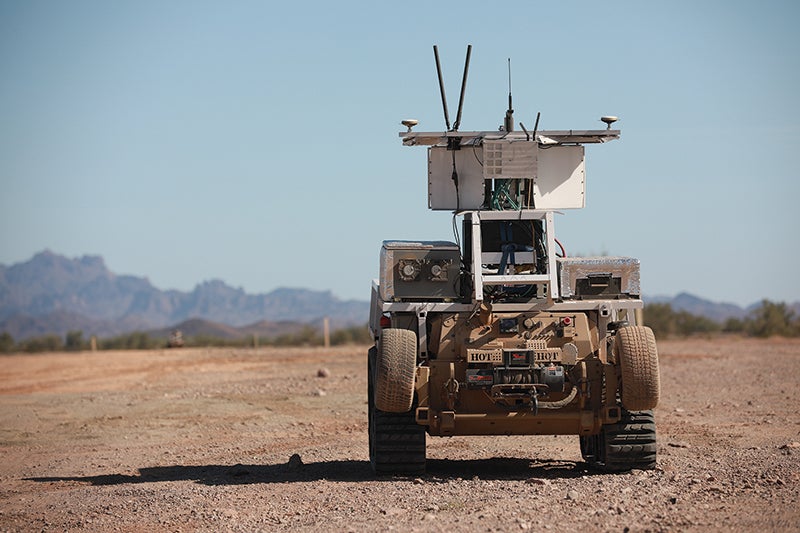
The Joint Force’s View of Future Warfare
The NDS states that the United States faces “an ever more lethal and disruptive battlefield, combined across domains, and conducted at increasing speed and reach—from close combat, throughout overseas theaters, and reaching to our homeland.”7 DoD has recognized the need for unprecedented jointness across all services, embodied in its conception of Joint-All Domain Operations (JADO). JADO asserts that prevailing in the next war will require rapidly integrating effects across all domains—land, sea, air, space and cyberspace—to present adversaries with multiple, simultaneous dilemmas.8
Data is the “ammunition” to achieve this all-domain convergence. As such, DoD continues to develop JADO’s enabler: Joint All-Domain Command and Control (JADC2). JADC2 is DoD’s concept to create a cloud-like environment to connect sensors from all the services into a unified network, facilitating seamless information sharing and faster decisionmaking.9 By utilizing artificial intelligence (AI) to process the data rapidly and recommend the optimal shooter, the U.S. military intends to achieve decision dominance and overmatch any adversary.
Multi-Domain Operations: The Army’s Contribution to JADO
As its contribution to JADO, the Army has developed the MDO concept. According to Army Training and Doctrine Command, MDO is defined as the “rapid and continuous integration of all domains of warfare.”10 Along with the joint force, the Army seeks to “counter and defeat a near-peer adversary capable of contesting the U.S. in all domains [air, land, maritime, space and cyberspace] in both competition and armed conflict.”11
The purpose of MDO is to provide combatant commanders a plethora of options for rapidly executing operations across all domains to present an adversary with multiple, simultaneous dilemmas.12 The joint force’s ability to deter and, if necessary, win a conflict is significantly enhanced if the Army is not only equipped to fight on land, but also to leverage its landpower capabilities to affect the air, sea, space and cyberspace.
A critical though often understated aspect of MDO is its emphasis on competition, during which the Army can set favorable conditions for potential conflict, thereby demonstrating to competitors that aggressive actions on their part would result in unacceptable costs. MDO’s focus on competition allows the Army to play an integral role in DoD’s “integrated deterrence” concept.13
Should deterrence fail, the Army, as part of the joint force, seeks to overmatch the adversary, win and return to competition on terms favorable to the United States. The Army will leverage positions of advantage secured during competition to provide the joint force with counter-A2/AD capabilities and create opportunities for joint freedom of action to overmatch an adversary.14
MDTFs: The Centerpiece of the Multi-Domain Modernization Effort
The MDTFs are the organizational centerpiece in the Army’s operationalization of MDO. MDTFs are theater-level, multi-domain maneuver elements that synchronize long-range precision effects (LRPE)—such as electronic warfare, space, cyber and information—with long-range precision fires (LRPF).15 MDTFs integrate these capabilities under one commander while the unit’s components conduct distributed operations to enhance survivability.
The role of the MDTFs is to persistently compete to gain positions of advantage that it can leverage in crisis or conflict. By integrating non-kinetic effects and kinetic fires across all domains, MDTFs provide combatant commanders with an enhanced menu of counter-A2/AD capabilities.16
The first MDTF—established in 2017 as an experimental unit at Joint Base Lewis-McChord—is focused on the Indo-Pacific. The Army’s second MDTF was activated on 16 September 2021 at U.S. Army Garrison Wiesbaden in Germany and is aligned to Europe. The Army plans to create three more MDTFs: a second for the Indo-Pacific theater, one for the Arctic and one for global response.17
MDTF Structure
The common elements of the MDTFs can be categorized into four functions: effects, fires, protection and sustainment (see Figure 1 and footnotes). While there are similarities between MDTFs, they are not one-size-fits-all. MDTF components are tailorable based on combatant commander needs.18 This bottom-up approach ensures that the MDTFs contain the specific organizational components needed to maximize their value to their area of operations.
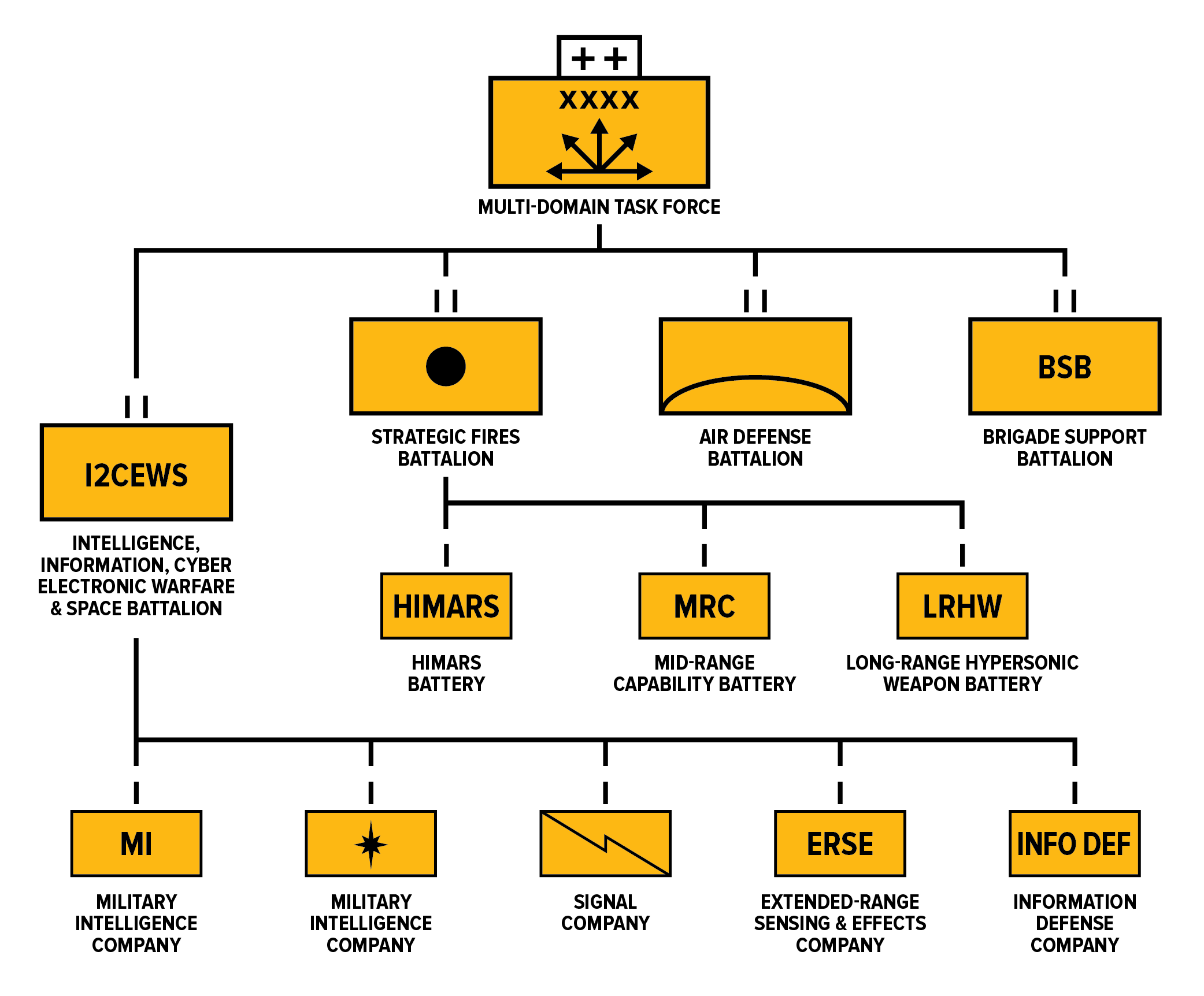
According to General John Murray, the initial commander of Army Futures Command, the “centerpiece of the Multi-Domain Task Force” is the Multi-Domain Effects Battalion (MDEB), previously named the Intelligence, Information, Cyber, Electronic Warfare and Space (I2CEWS) unit.19 MDEBs integrate traditional signals and military intelligence with capabilities in space, cyberspace, information space and the electromagnetic spectrum. Though much of the MDEB’s capabilities are classified, these units likely integrate data from a wide range of sensors, such as satellites and drones, to inform the MDTF’s fires elements while providing offensive capabilities like hacking and jamming enemy sensors and networks.20
The Strategic Fires Battalion exploits the intelligence capabilities provided by the MDEBs. The Army has made the development of LRPF its number one modernization priority, developing a suite of highly maneuverable and survivable fires.21 Significant for the MDTFs is the Army’s development of long-range hypersonic weapons—due to be fielded in Fiscal Year 2023—capable of bypassing adversary missile defenses.
MDTFs incorporate an Air Defense Battalion for force protection, including missile defense capabilities and a Direct Energy Battery. These air defenses are vital as adversaries employ increasingly capable targeting systems, missiles and drone swarms. In addition, MDTFs include a security force to provide ground force protection when operating in non-permissive environments. Finally, a Brigade Support Battalion plans, directs and supervises supply distribution and logistics—including field maintenance and medical capabilities.
The Army is creating All-Domain Operations Centers (ADOCs) that integrate the diverse components of the MDTFs. ADOCs are intended to serve as command nodes that enhance information-sharing, allowing commanders to see data from the field and provide faster analyses to ensure that MDTFs persistently compete from home station and while employed forward.22 The Army intends the ADOCs to be “joint from inception”23—fully networked across the joint interorganizational multinational (JIM) spectrum. It is not yet clear at what echelon the ADOCs will provide this integration and whether they would function complementary to centers like the Air Force’s Air Operations Center (AOC) to mitigate concerns that the AOC is a single point of failure,25 or if the Army envisions presence from all services.
The Role of the MDTFs in Competition, Crisis and Conflict
In support of the joint force, MDTFs seek to gain and maintain contact with the adversary in the competition phase, to contribute to de-escalation back to competition during a crisis and, should conflict occur, to help disrupt enemy A2/AD to enable joint force maneuver.26Most critically, MDTFs provide an enhanced array of options to combatant commanders—an essential added value as Chinese and Russian A2/AD may render specific U.S. capabilities ineffective.
To be sure, MDTFs are not a “silver bullet” for future conflict. MDTFs cannot deter conflict or dismantle adversary A2/AD networks on their own (nor can any military unit). MDTFs possess capabilities to achieve significant counter A2/AD effects, but their value is maximized when paired with the capabilities of each service.
Competition
Evident from assessing the role of MDTFs in competition is the essential nature of this phase; as Sun Tzu put it, “every battle is won before it is fought.” Successfully maneuvering to positions of advantage during competition forms the foundation for the MDTFs’ value in later contingencies.
MDTFs gain and maintain contact with the adversary to compete persistently.27 By maneuvering in all domains, MDTFs obtain positions of advantage during competition. Gaining these positions of relative advantage serves two primary functions: contributing to the Army and joint force’s deterrence posture and setting favorable conditions for potential conflict.
MDTFs, ideally forward deployed as an “inside force” within adversary A2/AD systems,28 can serve as an integral component of the Army’s landpower network. Stationing troops on the ground alongside allies and partners is a signal of U.S. resolve. Leveraging this forward positioning, MDTFs experiment and exercise with allies and partners. Such exercises—monitored closely by potential adversaries—are an opportunity to reveal some MDTF capabilities and inject doubt into adversary escalation calculus. The combination of boots on the ground to demonstrate resolve and exercises to demonstrate credibility is a potent contributor to deterrence.
In competition, MDEBs help set favorable conditions to exploit during a potential crisis or conflict. Intelligence gathered from collection platforms such as satellites, aerial platforms, adversary communications and cyber networks feeds the MDTFs and combatant commanders with information necessary to maintain situational awareness. Empowered by data, combatant commanders can respond quickly to a developing crisis to prevent it from escalating to conflict. According to U.S. Army Europe and Africa Commander General Chris Cavoli, MDEBs also actively shape the information space, possessing the requisite authorities to attribute and refute disinformation29 that adversaries may use to undermine the United States and allies or set the conditions for conflict.
Cyber and electronic warfare capabilities provide additional options for persistently competing. MDEBs can employ electronic transmissions to stimulate enemy radars, jammers, cyber defenses and ground units into responses that the MDTFs can analyze.30 MDEBs also contain the capacity to penetrate adversary cyber networks. During competition, these networks would be monitored for intelligence and scanned for vulnerabilities that the MDTFs could later exploit during a crisis or conflict. The MDEBs could intentionally reveal some successful cyber penetrations to an adversary to achieve cognitive and deterrent effects by signaling potential escalation costs.
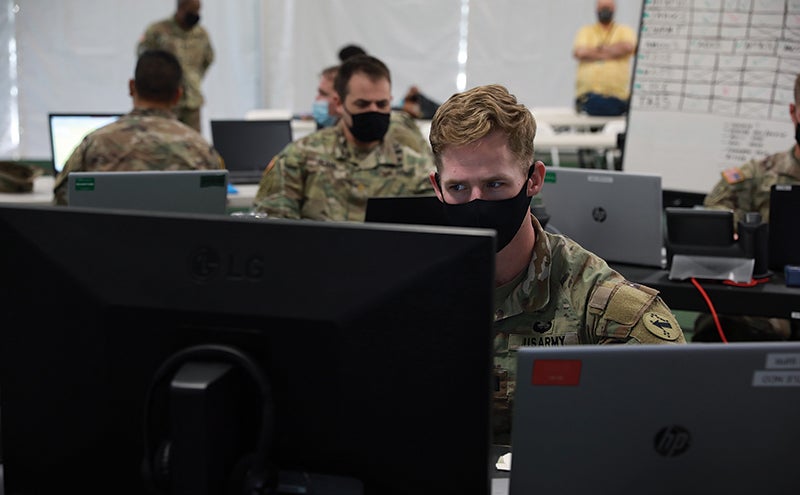
Crisis
The Army perceives crisis scenarios as the high end of the competition phase—the potential spark to transform strategic competition into conflict.31 MDTFs provide combatant commanders options to hold adversary interests credibly at-risk during crisis—thereby contributing to the joint force’s ability to deescalate a crisis and return to competition on terms favorable to the United States.
In the crisis phase, the MDTFs’ monitoring and shaping of the information environment could be paramount. By enabling the joint force commander to sense adversary actions across all domains, the MDTFs could help provide intelligence to preempt adversary aims (such as a fait accompli). Additionally, the MDEBs’ ability to counter adversary disinformation could allow U.S. and partner forces to maintain an accurate picture of developments and rebuff adversary attempts to prevent a collective response.
With sufficient situational awareness, the MDTFs would provide combatant commanders with kinetic and non-kinetic options to coerce de-escalation by an adversary. Compared to the competition phase, the MDTFs could more overtly reveal capabilities to the adversary. For example, an MDEB could temporarily disable an adversary cyber network to show that escalation could bring unacceptable costs. Any action would need to be well-calibrated to avoid conflict, such as an adversary’s perception that they must escalate before losing essential capabilities. However, a proportionate measure that signals U.S. capability while providing an off-ramp could coerce an adversary to return to competition.
Conflict
Should a crisis escalate to conflict, MDTFs provide options to integrate kinetic and non-kinetic effects that counter adversary A2/AD capabilities. In 2019, based on at least 10 exercises and wargames, then-commander of Army Pacific General Brown called the MDTFs a “game-changer” and remarked, “Before, we couldn’t penetrate A2/AD. With it, we could.”32
MDTFs largely generate their value from their unique capabilities as land forces. Because they are small, distributed and maneuverable, they may be more resilient against enemy fires than sea or air platforms. MDTFs can exploit terrain features—such as tunnels, tree cover and mountains—to hinder adversary targeting. Likewise, terrain presents opportunities for deception. MDTFs can employ cost-effective physical decoys (like fake missile launchers or vehicles) and electronic and cyber spoofing to stimulate enemy detection mechanisms. These decoys can fool enemy surveillance and targeting—including AI systems.33
Leveraging this survivability, MDTFs synchronize kinetic and non-kinetic effects to penetrate adversary A2/AD. MDTFs may utilize LRPE to disrupt adversary command and control (C2), communications and cyber networks. The MDTFs can also employ LRPF to destroy enemy targets—whether land-based forces such as infantry, air defenses, missile systems and C2 nodes, or adversary air and naval forces. MDTFs are working to operate non-formulaically, using AI to take advantage of emerging opportunities and to overmatch an adversary rapidly.
As Admiral Harry Harris, former commander of U.S. Indo-Pacific Command, put it, MDTFs must “sink ships, neutralize satellites, shoot down missiles and airplanes, and hack or jam the enemy’s ability to command and control.”34 MDTFs could intercept missiles aimed at U.S. Navy ships or shoot down enemy fighters targeting the U.S. Air Force. It could also drive enemy naval forces away from coasts into deep water where the U.S. Navy maintains significant undersea advantages over China and Russia.35 MDTFs thus support the goal of opening lanes for the joint force to close distance, target vital enemy interests and achieve overmatch. Enemies are more likely to terminate the conflict when facing multiple, simultaneous dilemmas.
Considerations for MDTFs in the Indo-Pacific and Europe
Given that MDTF-1 and MDTF-2 are aligned to the two priority regions for the U.S. defense strategy—the Indo-Pacific and Europe, respectively—it is worth considering how they could vary. Though both will serve the same overarching role and continue to adapt as they experiment, their organizational components could differ based on theater geography, regional security architecture and adversary capabilities.
The Indo-Pacific presents a wide array of challenges to the MDTF. First, much of the Indo-Pacific is characterized by vast distances of ocean interspersed by land. This geography results in less area for an MDTF to occupy for advantage (see Figure 2, which represents one example of Army long-range fires capabilities if based in the northern Philippines). As a further complication, no comprehensive regional security alliance exists in the Indo-Pacific; the United States relies primarily on bilateral agreements with Japan, South Korea, Australia, Thailand and the Philippines.37 This may make the political process of achieving bilateral agreements for MDTF basing in the region more difficult. Last, especially in the medium to long-term future, Chinese A2/AD systems are likely to surpass Russia’s quantitively and qualitatively, with more significant capability to disable the U.S. military’s communications.
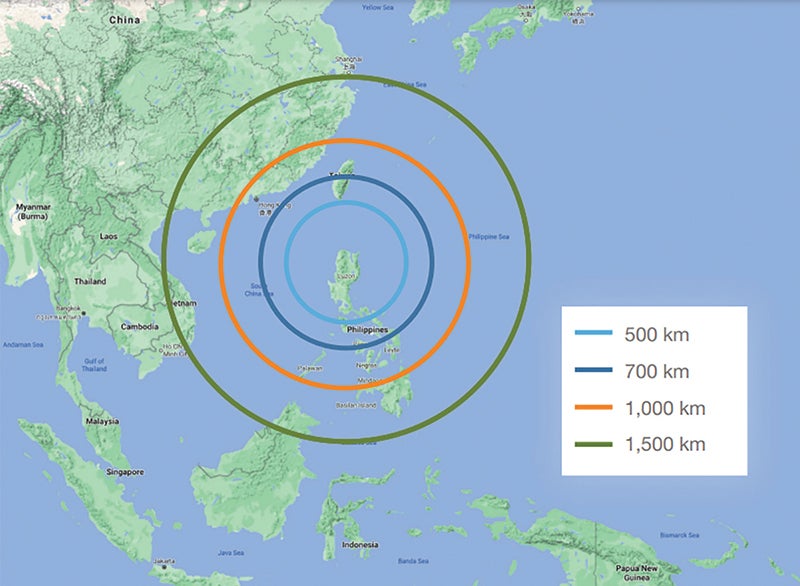
These factors could shape MDTF-1’s organizational components. For example, the geography of the Indo-Pacific may compel MDTF-1’s Long-Range Fires Battalion to rely more heavily on the Army’s Long-Range Hypersonic Weapon (LRHW)—capable of supersonic speeds at ranges of 1,725 miles and due to be fielded in 2023. The LRHW would have enough range from numerous locations in the Indo-Pacific to put Chinese land-based targets at risk in addition to its sea-based platforms. Depending on their locations, Army long-range fires with less range, such as the Precision Strike Missile (PrSM—capable of hitting targets at 800 miles) and Strategic Long-Range Cannon (SLRC—capable of hitting targets at 1,000 miles), could be effective in targeting Chinese maritime capabilities, notably during contingencies in Taiwan and the Senkaku Islands. However, for certain land-based targets, these weapons would benefit from closer positioning.
The distances within the Indo-Pacific also pose challenges to communications resilience, especially given China’s rapidly evolving space and cyber capabilities. Likewise, this geography makes sustaining the distributed operations of the MDTF in a contested environment difficult. As a result, MDTF-2’s MDEB may require additional Space and Signal Companies and a greater number of Distribution Companies for its Brigade Support Battalion. These demands partly explain why the Army plans for a second MDTF aligned to the Indo-Pacific; it is vital that the Army receives the necessary funding and quickly establishes this unit.
Unlike the Indo-Pacific’s vast oceans, Europe’s geography is dominated by land and much shorter distances (see Figure 3). Additionally, NATO could simplify the process of gaining MDTF basing arrangements across more locations in Europe, with the benefits of NATO’s robust infrastructure, including transportation networks and supply depots. In combination, favorable geography and security architecture increase the number of potential MDTF locations that could place Russian interests at risk. Further, over the medium- and long-term, as Russia faces economic constraints, it is unlikely that it will keep up with Chinese A2/AD capabilities and may rely on lower-cost options, particularly in the information domain.
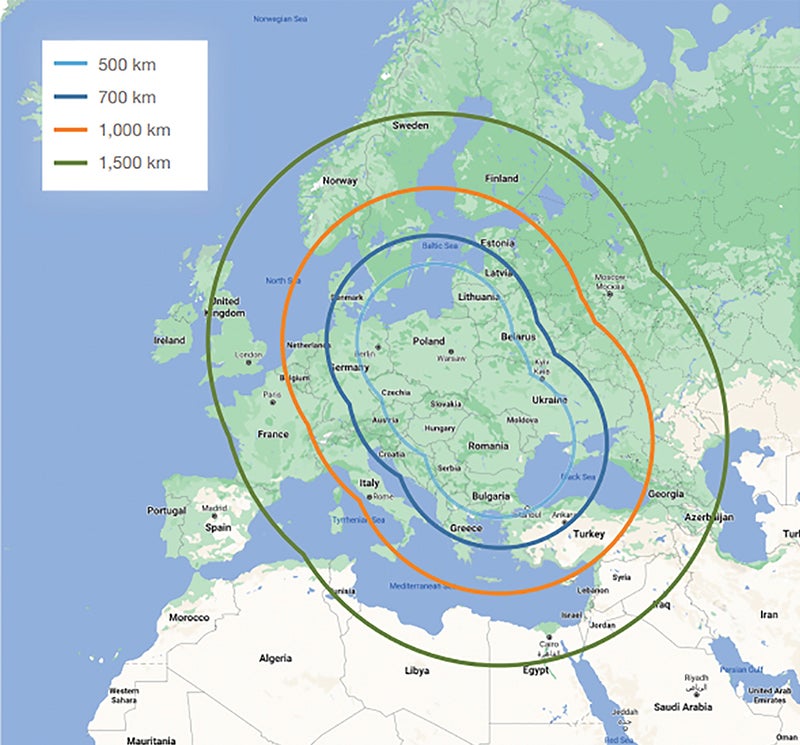
Due to these factors, PrSM and SLRC could play a more prominent role in MDTF-2’s fires units, as they would have ample range from many locations in Europe to target Russian forces attempting, for example, to invade the Baltic States; they could even place targets within Russia’s borders at risk. Additionally, MDTF-2’s MDEB could require an additional Information Defense Company to identify and counter Russian disinformation. Moscow has featured these low-cost cyber and information tools heavily in operations in Georgia, Crimea and Ukraine, and, more broadly, during competition with the United States and Europe. As Russia’s relative military power decreases and technologies with implications for the information environment, such as deepfakes, evolve, these low-cost cyber and information options could become more prominent. Thus, MDTF-2’s organizational structure may change to reflect this emphasis.
Critical Enablers of MDTFs
For the MDTFs, three external factors are essential: the efficacy of JADC2; MDO interoperability with allies; and gaining access in foreign countries within adversary A2/AD networks. The Army should plan for how the envisioned role of the MDTFs may change should one or more of these enablers not come to fruition.
Joint All-Domain Command and Control (JADC2)
MDTFs rely on data integration to provide the maximum number of options to combatant commanders—for example, to use land-based fires to target adversary sea capabilities. However, no service owns all the necessary sensors and shooters. Therefore, with JADC2’s integrated network, MDTFs can optimize their capacity to present adversaries with multiple dilemmas.
Second, JADC2’s AI capabilities can provide MDTFs with the necessary speed of data analysis to achieve overmatch against adversaries. While connecting all sensors into a unified network facilitates seamless data integration, it also creates challenges—namely, the volume of data will be enormous, making timely analysis difficult. Through JADC2’s AI capabilities, MDTFs will be able to analyze and act on information at the speed of relevance.
Finally, because MDTFs can conduct distributed operations across significant distances, the envisioned resilience of JADC2’s network is essential. Given that U.S. communications are likely to be degraded in a conflict with China or Russia, a network that can remain functional despite this degradation is critical. Otherwise, the MDTFs may struggle to integrate data and send it to the best available shooter, diminishing a joint force commander’s situational awareness and options.
Whether DoD can fully achieve JADC2 is an open question. DoD has conducted several major JADC2 exercises, in which data was collected, analyzed and shared in real-time between a limited number of platforms owned by different services.39 In October, the Army conducted Project Convergence 21 (PC21)—its annual contribution to JADC2’s development—bringing in participation from the joint force for the first time. This “campaign of learning” included exercises where the Army tested its ability to link sensor-to-shooter capabilities with the other services in real-world scenarios.40 Still, some are skeptical whether “it is even possible to field a network that can securely and reliably connect sensors to shooters . . . in a lethal, electronic warfare-rich environment.”41
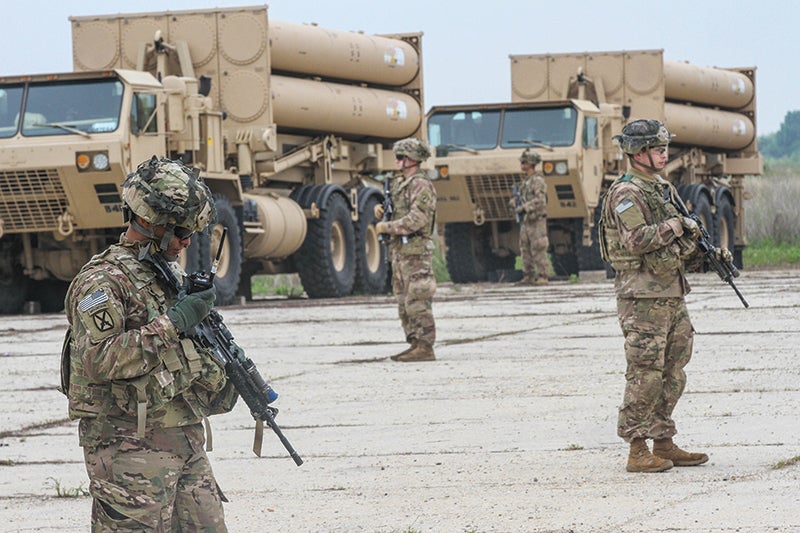
Operating as an Inside Force
The Army envisions MDTFs as an “inside force,” operating within adversary A2/AD networks.42 The closer MDTFs are to potential conflict points, the greater their ability to hold vital adversary interests at risk. For example, the closer an MDTF’s long-range fires unit is to an adversary’s territory, the more it can put its strategic support area at risk.
However, gaining access to foreign countries is a political question that neither the Army nor the U.S. government can directly control. Nations weigh the benefits of U.S. military presence against the costs that China or Russia can impose. Time, persuasion and the potential effects of hostile adversary action—not U.S. pressure—will achieve the most significant progress.
While the Army does not control these decisions, it can play a role. The Army should strive to achieve a common strategic understanding with allies and partners through high-level military-to-military contacts to convey its assessments of adversary capabilities and intentions. Exercises and demonstrations can also portray the value of the MDTFs when employed within adversary A2/AD networks. The Army’s efforts could be especially beneficial in the Indo-Pacific, where 21 of its 27 nations’ defense chiefs (about 78 percent) are army officers.43 By contrast, 19 of the 30 defense chiefs in NATO (approximately 63 percent) are army officers.44 Over time, the effect of achieving common military-to-military perspectives could influence political decisions.
Multi-Domain Interoperability with Allies
As General Murray observed, “The Army approaches [the future fight] with the belief that we will never fight alone.”45 Beyond merely gaining a presence in foreign countries, MDTFs must conduct MDO alongside partners and allies.
However, several challenges exist to achieving MDO interoperability. There exists no consistent way of describing the multi-domain environment between the United States and many of its allies.46 Moreover, there is no common operating system underpinning allied AI. This lack of standardization risks that these systems could be incompatible for sharing data seamlessly.47 Additionally, smaller allies and partners may lack the necessary capabilities to contribute fully to MDO. If the Army fails to maintain constant engagement with allies regarding modernization efforts, there is a risk that “U.S. capabilities will diverge from allied systems, making the level of integration necessary to achieve convergence unworkable.”48
Fortunately, the Army is bringing allies and partners on board. After PC21 brought on joint partners, Project Convergence 2022 (PC22) will bring in allies.49 While PC22 will likely focus on Five Eyes partners, the Army intends to bring in a more expansive group from Europe and the Indo-Pacific in future years. The more partners and allies that understand MDO, the greater their ability to invest in compatible systems, to understand the capabilities they can contribute and to enhance the concept’s effectiveness.
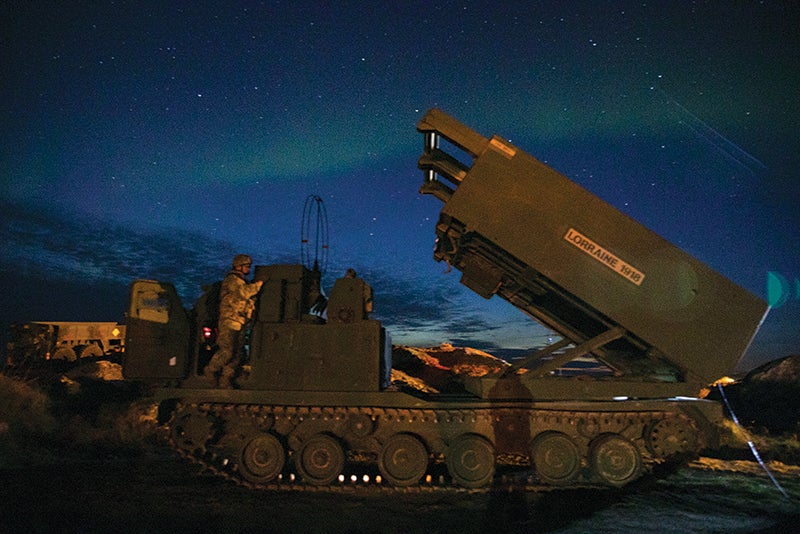
Recommendations
Army
Recommendation #1: Expand realistic MDTF experimentation, wargames and exercises with the joint force, allies and partners to demonstrate MDTF value and influence adversary perceptions of U.S. capabilities.
Recommendation #2: Leverage military-to-military contacts to promote shared understandings of the strategic and operational environments that will facilitate future MDTF integration with prospective allies and partners.
Recommendation #3: Identify and integrate niche multi-domain capabilities of smaller allies and partners (e.g., Eastern European expertise in cyberspace and the information domain) to ensure that multi-domain interoperability is not only achieved by the most capable allies.
Office of the Secretary of Defense
Recommendation #1: Create a central authority to integrate the development of JADC2. Doing so will mitigate concerns that current efforts by each service to develop their respective networks will be unable to converge to create a genuinely joint network.
Recommendation #2: Communicate to Congress that MDO is essential for the future fight and identify the vital modernization programs that Congress must prioritize for the United States to prevail on the multi-domain battlefield.
Congress
Recommendation #1: Provide consistent and sufficient funding for MDTFs and all-domain modernization efforts of the joint force, including investment in LRPF and emerging cyber, space, information and AI technologies.
Recommendation #2: Increase congressional foreign policy engagement with allies and partners to promote stability and build resilient trust. Doing so can set the foundation for more expansive military engagement and basing arrangements, such as MDTF presence.
Recommendation #3: Avoid the “one-issue fallacy”50—overprioritizing China and so creating excessive vulnerabilities from other threats. With Washington’s poor record of predicting its next war, underinvesting in U.S. landpower is myopic for the Indo-Pacific theater and perilous if its next fight occurs with Russia, Iran, North Korea or elsewhere.
Conclusion
MDTFs represent a critical pillar of the Army’s aggressive modernization. Integrating LRPF and LRPE in a highly survivable land-based unit provides the joint force commander with unique options. By gaining positions of advantage during competition, MDTFs form an invaluable component of the joint force’s deterrence posture and counter-A2/AD options in conflict. Critically, the MDTFs’ value lies not only in its role in a conflict but also in the day-to-day competition that is already occurring.
To be sure, the challenges facing the United States extend far beyond the Pentagon and require a revitalization of American economics and diplomacy. However, the surest way for Washington to invite conflict is through degradation of its military capabilities. At this inflection point, Congress and the American public should recognize that the costs of making the necessary investments to ensure national security would pale in comparison to the costs of ceding its global position to China or Russia.
★ ★ ★ ★
Charles McEnany is a National Security Analyst at the Association of the United States Army. He holds an MA in Security Policy Studies from George Washington University.
- Richard Haass, Foreign Policy Begins at Home (New York: Basic Books, 2013), 9.
- Sydney J. Freedberg Jr., “Army’s Multi-Domain Unit ‘A Game-Changer’ In Future War,” Breaking Defense, 1 April 2019.
- James Mattis, Summary of the 2018 National Defense Strategy of the United States of America, January 2018, 2.
- Congressional Research Service, “The Army’s Multi-Domain Task Force (MDTF),” 29 March 2021.
- Chris Dougherty, “Moving Beyond A2/AD,” Center for a New American Security, 3 December 2020.
- Billy Fabian, “Overcoming the Tyranny of Time: The Role of U.S. Forward Posture in Deterrence and Defense,” Center for a New American Security, 21 September 2020.
- Mattis, Summary of the 2018 National Defense Strategy of the United States of America, 3.
- Air Force Chief of Staff GEN David Goldfein, “Joint All-Domain Command and Control,” speech at the Air Force Association, 17 September 2019.
- Congressional Research Service, “Joint All-Domain Command and Control (JADC2),” 1 July 2021.
- U.S. Army Training and Doctrine Command (TRADOC), TRADOC Pamphlet 525-3-1: The U.S. Army in Multi-Domain Operations 2028, 6 December 2018, iii.
- Congressional Research Service, “Defense Primer: Army Multi-Domain Operations (MDO),” 22 October 2021.
- LTG Stephen Lanza, USA, Ret., and COL Daniel S. Roper, USA, Ret., “Fires for Effects: 10 Questions about Army Long-Range Precision Fires in the Joint Fight,” Association of the United States Army, August 2021, 5.
- C. Todd Lopez, “Defense Secretary Says ‘Integrated Deterrence’ Is Cornerstone of U.S. Defense,” Department of Defense News, 30 April 2021.
- Department of the Army, Army-Multi Domain Transformation: Ready to Win in Competition and Conflict: Chief of Staff Paper #1, 16 March 2021, 8.
- Department of the Army, Army Multi-Domain Transformation, 12.
- Department of the Army, Army Multi-Domain Transformation, 12.
- Congressional Research Service, “The Army’s Multi-Domain Task Force (MDTF).”
- Department of the Army, Army Multi-Domain Transformation, 12.
- Thomas Brading, “Talent management key to filling future specialized MDO units,” Army News Service, 21 May 2020.
- Freedberg, “Army’s Multi-Domain Unit ‘A Game-Changer’ In Future War.”
- Lanza and Roper, “Fires for Effects: 10 Questions about Army Long-Range Precision Fires in the Joint Fight,” 4.
- Jackson Barnett, “Army building new All-Domain Operations Centers,” Fed Scoop, 26 March 2021.
- Barnett, “Army building new All-Domain Operations Centers.”
- Department of the Army, Army Multi-Domain Transformation, 12.
- Sherrill Lingel et al., Joint All-Domain Command and Control for Modern Warfare: An Analytic Framework for Identifying and Developing Artificial Intelligence Applications (Santa Monica, CA: RAND, 2020), iii.
- Department of the Army, Army Multi-Domain Transformation, 12.
- Department of the Army, Army Multi-Domain Transformation, 12.
- Lanza and Roper, “Fires for Effects: 10 Questions about Army Long-Range Precision Fires in the Joint Fight,” 8.
- GEN Christopher G. Cavoli, USA, “AUSA Noon Report – Gen. Christopher Cavoli,” virtual remarks to the Association of the United States Army, 3 February 2021.
- Freedberg, “Army’s Multi-Domain Unit ‘A Game-Changer’ In Future War.”
- Department of the Army, Army Multi-Domain Transformation, 10.
- Freedberg, “Army’s Multi-Domain Unit ‘A Game-Changer’ In Future War.”
- Rémy Hémez, “To Survive, Deceive: Decoys in Land Warfare,” War on the Rocks, 22 April 2021.
- Admiral Harry B. Harris, Jr, “Association of the United States Army Conference,” virtual speech to the Association of the United States Army Annual Meeting, 4 October 2016.
- Frank Hoffman, “Extending that ‘Loving Feeling” to Undersea Warfare,” War on the Rocks, 3 November 2021.
- John Gordon IV and John Matsumura, Army Theater Fires Command: Integration and Control of Very Long-Range Army Fires (Santa Monica, CA: RAND, 2021), 6.
- Gordon and Matsumura, Army Theater Fires Command, 6.
- Gordon and Matsumura, Army Theater Fires Command, 5.
- Congressional Research Service, “Joint All-Domain Command and Control (JADC2).”
- U.S. Army Futures Command, “Project Convergence."
- Congressional Research Service, “Joint All-Domain Command and Control (JADC2).”
- Lanza and Roper, “Fires for Effects: 10 Questions about Army Long-Range Precision Fires in the Joint Fight,” 8.
- Lanza and Roper, “Fires for Effects: 10 Questions about Army Long-Range Precision Fires in the Joint Fight,” 2.
- “NATO Chiefs of Defense,” North Atlantic Treaty Organization, last modified 8 December 2021.
- Joseph Lacdan, “Project Convergence 21 to showcase abilities of the joint force,” Army Services Network, 16 August 2021.
- Dr. Jack Watling and COL Daniel S. Roper, USA, Ret., “European Allies in US Multi-Domain Operations,” Royal United Services Institute, October 2019, v.
- Watling and Roper, “European Allies in US Multi-Domain Operations,” v.
- Watling and Roper, “European Allies in US Multi-Domain Operations,” v.
- Congressional Research Service, “The Army’s Project Convergence,” 27 September 2021, 2.
- Richard Fontaine, “What the New China Focus Gets Wrong,” Foreign Affairs, 2 November 2021.
The views and opinions of our authors do not necessarily reflect the views of the Association of the United States Army. An article selected for publication represents research by the author(s) which, in the opinion of the Association, will contribute to the discussion of a particular defense or national security issue. These articles should not be taken to represent the views of the Department of the Army, the Department of Defense, the United States government, the Association of the United States Army or its members.

